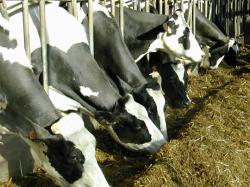Dairy Market Update: What’s Ahead For Economy, Input Costs & Retail Food Prices
November 4, 2010 | 2 min to read

While federal economists say recovery from the recent recession remains slow, the country's gross domestic product is expected to grow. However, feed and energy costs for the U.S. dairy industry appear to be headed higher. The expected price for corn, just one example, may reach its highest marketing-year average in history. According to the U.S. Department of Agriculture, those higher input costs likely will raise retail prices for all food products, but consumers buying dairy products may notice the biggest price hikes.
It has been nearly two months since the National Bureau of Economic Research announced that the recent recession officially lasted 18 months and ended in June 2009¹. However, many claim that the recovery has been slow. The Federal Reserve Bank recently reported that "on balance, national economic activity continued to rise, albeit at a modest pace"² during the most recent reporting period ending earlier this month.
Looking ahead, the Congressional Budget Office recently said "CBO expects-as do most private forecasters-that the economic recovery will proceed at a modest pace during the next few years."³ The macroeconomic forecasts used most recently by the Department of Energy's Energy Information Administration (EIA) indicate that U.S. GDP is expected to grow by 2.6 percent in 2010 and slow to a growth of 2.1 percent in 2011.
The costs of various inputs used extensively by the U.S. dairy industry are expected to be higher in the coming year. For example, the EIA forecasts that the U.S. benchmark oil price, West Texas Intermediate Crude, will average $83 per barrel in 2011 compared to an average of only $77.50 through September of this year. In fact, the forecast expects that price to equal or exceed $80 in every month next year; for perspective, there have only been 14 months in history when that benchmark has been at that level or above. The EIA forecast includes similar higher prices for the full range of U.S. energy inputs, including gasoline, diesel fuel, electricity and natural gas.
Dairy farm operations are facing the expectation that feed prices will also be much higher in the coming year. USDA's most recent Feed Outlook report released October 12 forecasts higher prices (as do the other reports released that day for wheat and oil crops). For example, the price for corn in the coming marketing year (which began September 1) is expected to average between $4.60 and $5.40 per bushel after an average of $3.55 last marketing year. For perspective, that would be the highest marketing-year average in history. Since the release of that Feed Outlook by USDA, corn futures contract prices at the CME Group have increased in recent weeks and ended the day on October 27 averaging about $5.70 per bushel for this coming marketing year.
Higher commodity costs for energy and agricultural items are expected to affect food prices in the coming year. USDA's Consumer Price Index for Food Forecasts, updated October 25, indicate that the All Food CPI will increase between 2 percent and 3 percent in 2011, after a projected increase of between 0.5 percent and 1.5 percent in 2010. However, the food CPI category expected to increase the most in 2010 is Dairy Products, with an expected increase of between 4.5 percent and 5.5 percent in 2011 after a projected increase of only 1.5 percent to 2.5 percent in 2010.
Source: International Dairy Foods Association.
